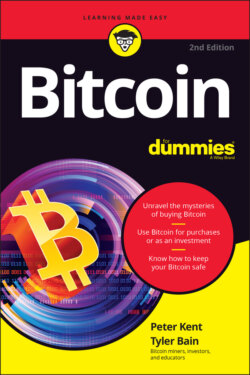Читать книгу Bitcoin For Dummies - Peter Kent - Страница 13
The Birth of Bitcoin
ОглавлениеOn November 1, 2008, someone named Satoshi Nakamoto posted a message to a cryptography forum, titled Bitcoin P2P e-cash paper (archived at https://www.mail-archive.com/cryptography@metzdowd.com/msg09959.html). In his message, Nakamoto announced that he had “been working on a new electronic cash system that's fully peer-to-peer, with no trusted third party.”
In other words, he’d created a currency system that worked on a network of peers — computers working together with each equal to the other. With no central power required, no bank or government to act as a “trusted third party” was required.
A comment he made in the post explained his view of the problem with the earlier cryptocurrencies. “A lot of people automatically dismiss e-currency as a lost cause because of all the companies that failed since the 1990s,” he said. He believed that these other digital-money systems had a critical weakness, an Achilles heel. “I hope it’s obvious it was only the centrally controlled nature of those systems that doomed them. I think this is the first time we’re trying a decentralized, non-trust-based system.”
Nakamoto had previously set up a domain name and a simple website, bitcoin.org, and there he posted a document explaining how all this would work: https://bitcoin.org/bitcoin.pdf. You might want to take a quick look, though it’s not essential for your understanding of Bitcoin (it’s pretty geeky stuff).
The whitepaper he posted describes how a blockchain (a special form of database) could be used to manage the currency. Essentially, the blockchain records a ledger, a record of currency transactions, and because the blockchain is duplicated over numerous computers (the peers) and because these peers are all equal, no trust in a central party is required. You may hear Bitcoin described as a “trustless” system. That doesn’t mean it can’t be trusted; it means that a trusted third party is not required. The trust, in effect, is baked into the system. The mathematics — or mathemagics, as Peter likes to call it — which powers the system means that Bitcoin transactions can be trusted, even without a central “power” overseeing the system. (See Chapter 2 for an explanation of why.)
Satoshi Nakamoto (whoever he, she, or it is) didn’t use the words cryptocurrency, blockchain, or trustless anywhere in the whitepaper. Those are terms that others applied to the system later.
The idea of blockchain had actually been around for a while — at least since 1991 — in fact, remember David Chaum of DigiCash fame? He had been working with the idea of a blockchain since the early 1990s.
Anyway, Nakamoto didn’t stop there. In January of 2009, he/she/it launched the Bitcoin network. Nakamoto released some thirty-thousand lines of code that defined the network protocols and processes necessary to operate this peer-to-peer, decentralized money system. And Bitcoin was born.
Of course, in January of 2009, Bitcoin had essentially no value. Still, the genesis block created by Nakamoto (the very first block of data in the blockchain creating the first 50 Bitcoins), along with subsequent blocks of data “mined” by Nakamoto (see Chapter 7), comprise perhaps a million Bitcoins: At current prices, that’s $47,369,000,000. Yes, close to 50 billion dollars!
